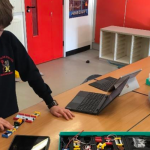Mindfulness is a great tool for us adults to find balance in our hectic life – but what about the little ones? Surely you don’t have to talk to children about the deeper, complex philosophical foundations of Buddhist and Hindu teachings. However, there are proven benefits to starting early.
The key is to choose age-appropriate methods that will help them enjoy the practice. What does that entail? What do we mean when we talk about mindfulness for kids? Keep reading to find out and discover fun mindfulness activities for kids!
What is mindfulness for kids?
Emotional and mental self-regulation skills are learned at young ages, and this is where mindfulness activities for kids come into the picture. Mindfulness for kids is about teaching them how to pay attention to the present moment, to their body and their surroundings. It equips them with tools for self-awareness, self-acceptance, and confidence, and how to shift their attention amidst the distractions of everyday life.
Simple mindfulness meditation exercises can support children’s healthy development and set them up for success in their adult life.
Importance of Mindfulness Exercises for Kids
The overall positive effects of meditation on psychological and cognitive well-being have been proven in clinical trials and research. But what about the importance of mindfulness for kids?
Research suggests that the same benefits apply to adults and children alike. Here are some of the myriad benefits of mindfulness that can help you and your children:
- Improves overall well-being
- Combats anxiety
- Better self-regulation of emotions and stress
- Increases calmness
- Helps with attention span issues, improves focus
- Develops social skills and respect
- Improves memory skills and remembering details
- Improves analytical skills such as metacognition, planning, and organizing
5 Mindfulness Activities for Kids
Square Breathing
Here is a fun mindfulness exercise consisting of mindful breathing and a bit of mathematics! Ask your child to inhale deeply while counting up to 4, then pause for another 4, and exhale up to a count of 4. Finally, count to another 4 after emptying the big breath to complete your “square”.
If you want, you can increase the count for a deeper, more engaging breath. This exercise is especially great when they are feeling stressed or dealing with a difficult emotion. (It also helps us adults when our wounded inner child takes over!)
Mindfulness Walk in Nature
Taking long walks in the nature has proven benefits on the mind. It’s a great opportunity to let the mind take a break and indulge in the calming effect of natural surroundings. Especially when we are stuck in our routine commute between work/school and home, confined between four walls for the majority of our days!
Plan a “scavenger hunt” list beforehand, with goals to notice certain kinds of animals and plants on your walk. This will help your child be more attentive to their surroundings, and make it a fun, gamified exercise. You can even encourage them to keep a journal and write their observations regularly.
Engage the Five Senses
Holistic mindfulness exercises help ground the mind in the body and the physical environment. A great way to do this is targeting the five senses: sight, taste, touch, smell, and sound. There is no single recipe to do this. But the essential idea is to stimulate the senses, and perhaps isolate one sense at a time.
One example is a blindfolded taste test, trying to guess the flavour by smelling and eating the sample. The blindfold can be kept on and used for the similar experience, but with sounds. Have your child guess the source and location of a sound inside the house (or perhaps outside).
Mindful Poses
You probably heard of “power posing” and how it can boost your confidence and mood. Why not encourage your child to give the art of mindful posing a go? You can try classic yoga poses such as the warrior(s), happy baby, child’s pose. Or the “superhero” pose—let them stand tall with their feet a little wider than hip-width, with hands placed on their hips or reached to the sky. Ask them if they notice any changes in their mind afterwards, and watch them unleash their inner superhero!
Scan the Body
The body scan meditation aims to bring mindful attention towards the body, and helps release tension. You can opt for this exercise especially before bedtime to offer your child a calm, peaceful sleep. It consists of laying down in a silent room, taking deep breaths and focusing on different parts of the body one by one.
Guide them to focus on the feet, legs, belly, chest, hands, arms, the back, neck, shoulders, face, and finally head. For extra relaxation, you can ask them to gently squeeze the muscles they are focusing on, hold for a few seconds, then release.
How do you practice mindfulness in children?
You might be thinking, “I can’t even them to sit through a feature film, how can I introduce my child to mindfulness?” It surely takes patience, but there are many ways to teach mindfulness to kids. With their ever-curious minds, they are naturally inclined to focus on details of the present. All they need is a little guidance.
The question is, then, not whether they can practice mindfulness, but how to encourage mindfulness in kids. Let’s go through some of the best practices to guide your child in building a habit of mindfulness:
Lead by example
Children are like mirrors of their caretakers. They see the adults around them as embodying the ideal ways to go through life. In other words, what you do is what you will get. Especially for smaller children, how you act in your everyday life, how you approach emotionally challenging situations can have a moulding effect.
Even if it is small breathing exercises or stopping for a moment of gratitude meditation, make sure that you integrate mindfulness in your daily life. Whenever possible, explain to your child what you are doing and how it may help.
Make it a routine
The mind, like the rest of the body, is essentially all muscle. To maintain the muscles in good condition, you need consistency. Just like regular exercise is essential to keep up the overall condition of the body, mindfulness exercises also work much better with regular practice. Allocating a specific time in the day, for at least 5-10 minutes, will ensure a healthy regularity. The key is to show up for it, even on difficult days.
Do it together
Families that practice mindfulness together, stay serene together! When it comes to trying out new things, children love being supported by family members. Take this opportunity to make it a fun activity for some quality family time. You can try parent-children yoga or meditation classes, or try out simple exercises at home together. Reflecting on the experience afterwards will create space for deeper conversations and bonding.
Support the practice with games, videos, apps
Children nowadays have an attention span that’s hard to capture, and it may be a good idea to get support for the exercises. There are plenty of great resources created and curated by experts in mindfulness for kids. Guided meditation apps and videos and mindfulness games appropriate for their age can be very useful.
Recognize and validate emotions
To make mindfulness a consistent part of everyday life, you should encourage the practice of emotional self-acceptance and validation. The way caretakers respond to children’s emotions shape their inner responses. Hence, if you want your child to listen to their body and mind, accept it as it is, you should practice the same thing in your relationship. Make it a regular routine to check on your child’s emotions, talk about them and recognize them. Let them know whatever they feel is valid, and that they are worthy of love and acceptance as they are.



